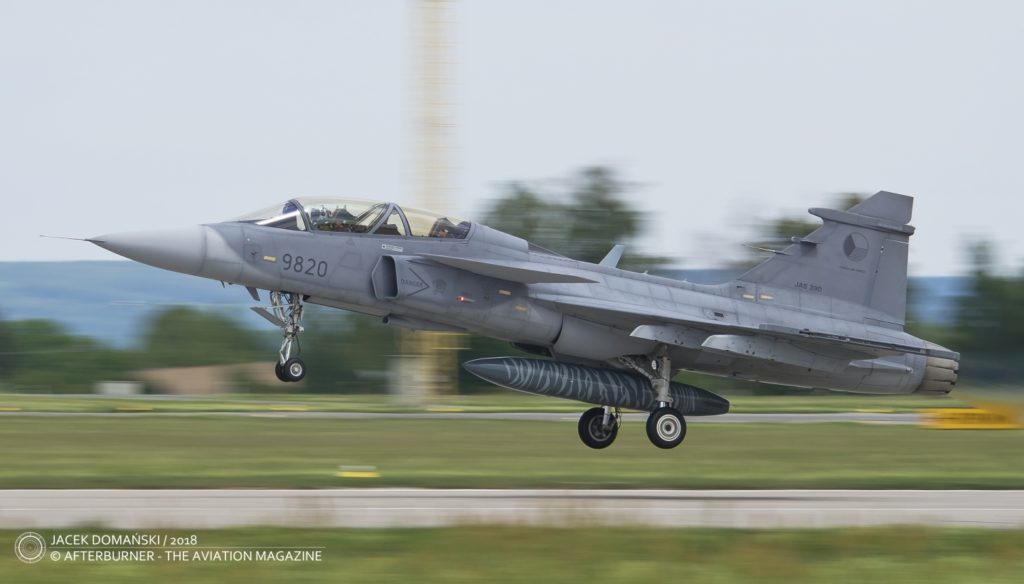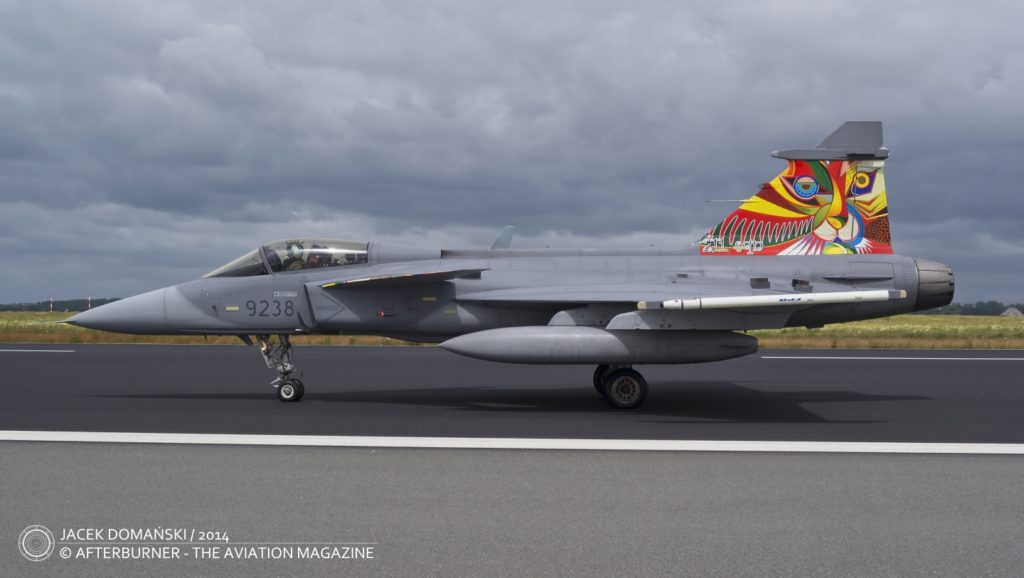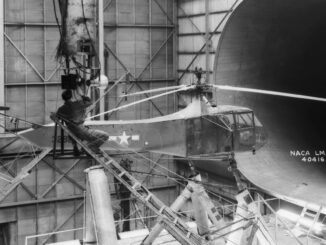 On 9th December 1988, a light multirole fighter JAS 39, developed by the Swedish aerospace company Saab AB, performed its approximately fifty minutes long maiden flight. The aeroplane was flown by Stig Holmström, company test pilot.
On 9th December 1988, a light multirole fighter JAS 39, developed by the Swedish aerospace company Saab AB, performed its approximately fifty minutes long maiden flight. The aeroplane was flown by Stig Holmström, company test pilot.
Yet in the early 1970s, just at the time when Saab 37 Viggen fighter aircraft entered operational service, Swedish military authorities began defining requirements for its successor. The new aeroplane had to comply with specific needs of the Swedish Air Force, based on dispersed operations doctrine. They included short take-off and landing capability, easy maintenance, minimal personnel and ground support requirement, as well as short time needed for refuel and re-arm. Following the first conclusions from operational service of the Viggen, the new fighter had to be smaller, although keeping the same – or even better – combat abilities.
As usual, Swedish neutrality was taken into consideration and, similarly to previous fighters, the new aircraft had to be domestically developed and manufactured. Once again, the task to create that aeroplane was assigned to the Saab company.
In 1979, following early studies of the future fighter, the Swedish government launched a programme called JAS. This abbreviation – later incorporated into the official name of the aircraft – stands for Jakt (literally: hunting), Attack and Spaning (reconnaissance) and describes the multirole characteristics of the new aeroplane. The goal was to create all-in-one versatile platform, able to perform air-to-air intercept duties, close air support tasks and reconnaissance missions without necessity of developing severa versions of the aeroplane, dedicated to each of abovementioned roles.
One year later, a joint venture company named Industrigruppen JAS was created, consisting of leading Swedish industrial and aviation companies – such as Saab-Scania, Volvo Flygmotor or LM Ericsson – as well as the Swedish armed forces. Although branded Saab and developed under the company’s supervision, creation of the new Swedish fighter was a joint effort of several domestic companies.
On 26th April 1987, celebrating the 50th anniversary of the Saab company, the new JAS 39 fighter was officially disclosed to public. The aircraft was named Gripen (English: griffin), as a result of public competition. Although its maiden flight was initially scheduled to follow shortly after the roll out, it was delayed for more than a year due to issues with flight control system. Finally, on 9th December 1988, the Gripen took-off into the skies.

The aircraft created by the JAS consortium was the single-engine, light fighter aircraft of canard configuration. Intentionally, to improve its manoeuvrability, the Gripen was aerodynamically unstable and could fly only through fly-by-wire technology to maintain its stability. The aeroplane was powered by Volvo RM12 turbofan engine and featured an advanced avionics suite, allowing the Gripen to perform all tasks from the JAS triad within a single mission.
And it was exactly the fly-by-wire system that caused the biggest issue during the Gripen testing phase. It also led to crash of the first prototype in February of 1989, fortunately just with minor injury to the pilot. Evaluation and improvement of the flight control system lasted until December of 1993 and finally concluded in more than satisfactory results.
In the meantime, the Swedish Air Force (Flygvapnet) ordered more than two hundred Gripens, in three batches. First production aircraft were ready in 1993 and deliveries continued, according to the schedule, until the end of 2008.
The Saab JAS 39 Gripen officially entered operational service with the Swedish Air Force on 1st November 1997, with F 7 Såtenäs unit, also known as the Skaraborg Wing.
The aircraft from the first and second batches were manufactured and delivered in A (single-seat) and B (two-seat) variants. However, in the mid-1990s an upgraded version of the fighter was developed and designated C and D, respectively. The modernized Gripen was compatible with the NATO standards and intended also for export.
Advertised as cost-effective alternative to bigger multirole fighters – simple in maintenance but exceptional in its capabilities – the Gripen was, and still is, participating in dozen bids all over the world. One of its main advances is possibility to use a broad range of Western armament – thanks to its advanced avionics suite, the Gripen can easily be adopted to be equipped with most of existing missiles, bombs or reconnaissance sensor pods.

In 1999, the South African government signed the contract for twenty six Gripen of C/D configuration, therefore officially becoming the first export customer for the new Swedish fighter. Later that year, the South Arfica was followed by the United Kingdom that acquired Gripen D aircraft for the Empire Test Pilots´ School via a leasing agreement.
In November of 2001, Hungary had announced procurement of fourteen Gripen A/B aircraft. Nevertheless, that contract was altered in 2003 and finally the Hungarian Air Force acquired twelve JAS 39C and two JAS 39D fighters via the leasing agreement. They came from the Swedish Air Force storage, being initially manufactured as A/B variants and then upgraded to the NATO standard.
In December of 2001, also the Czech Republic had chosen the Gripen as the country´s future fighter aircraft. Nevertheless, budget cuts delayed the purchase and the deal was concluded only in 2004 but via the leasing agreement for fourteen C/D aeroplanes, including maintenance and training.
The Royal Thai Air Force was the next customer, that acquired six aircraft in 2008 and another six in 2011. Deliveries were concluded in September of 2013 and currently the RTAF operates eight C and four D aircraft.
In 2007, the Saab company launched a programme of creating significantly modernized aircraft, based on the Gripen airframe. The project was named Gripen NG (Next Generation) and the aeroplane was for the first time disclosed to public in April of 2008. One month later, the Gripen NG successfully performed its maiden flight.
The new aircraft was characterized by incorporating a more powerful engine, General Electric F414G, as well as increased capacity of internal fuel tanks, increased range and redesignated undercarriage. Certainly, the new Gripen received a completely redesigned avionics suite, new radar and mission computer.
In 2016, the Gripen NG evaluated into the new, production variant of the fighter, designated Gripen E (and F, for its two-seat version). That aircraft performed its maiden flight on 15th June 2017.

Despite still being under development, the Gripen NG won a tender for the future Brazilian fighter. The final phase of that bid lasted between 2010 and 2013. Eventually, the contract for twenty eight E and eight F jets was signed on 24th October 2014.
In 2022, the first six Gripen E left the assembly line. Four aircraft were intended for the Brazilian Air Force and the other two were delivered to the Swedish Air Force.
Although the Gripen achieved international recognition and was acquired by six air forces on four continents, as well as became the biggest Swedish military export by financial amount, its export sales go not quite as good as initially expected by the manufacturer. The list of lost tenders includes Bulgaria, Croatia, Canada, Denmark, Finland, the Netherlands, Norway, Poland, Slovakia and Switzerland. However, it should be recognized that sometimes political reasons were impacting the choice of new fighter aircraft, other than the Gripen.
Nevertheless, the Swedish company does not cease its efforts to increase the number of the JAS 39 operators. Among potential customers, there could be such countries as Argentina, Colombia, Portugal or Philippines.
On the other hand, the latest developments of international situation can significantly revise the plans and forecasts. It seems like nowadays the NATO countries are even more integrating their fighter fleets and the F-35 Lightning II is the most preferred aircraft. That was a reason why the Gripen lost the Canadian bid and recently the F-35 was also chosen by Switzerland and Finland. Also the Czech government, taking into account the oncoming expiry of the Gripen leasing contract, already announced that the country is opting for acquiring the Lightning II fighters, instead of renewing the lease of the Swedish fighters.
However, several non-NATO countries will shortly be addressed by problem of upgrading their fighter fleets. Most of them will never have enough resources to buy and maintain the 5th generation fighter and such markets seem to be the great chance for the Gripen E.




